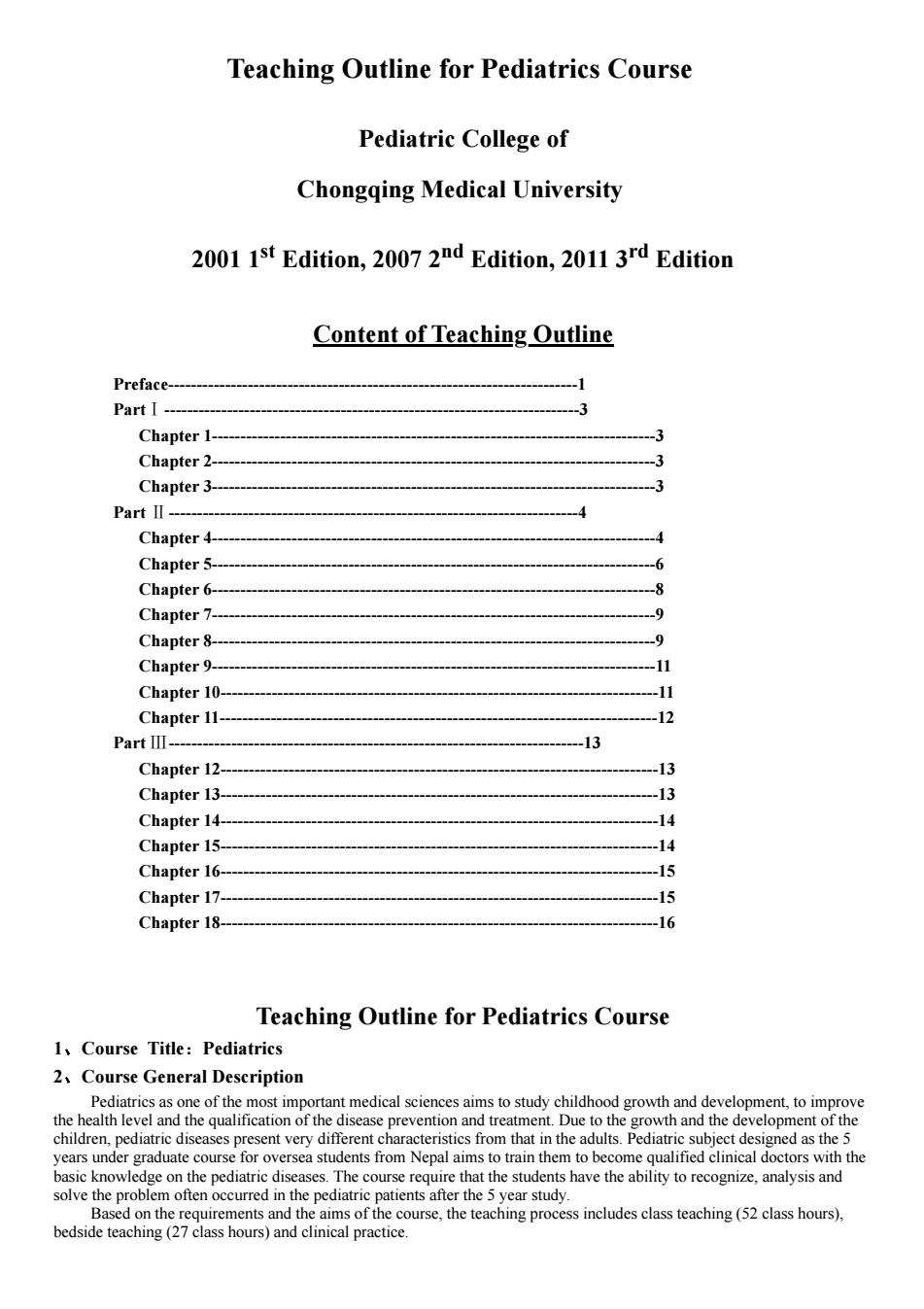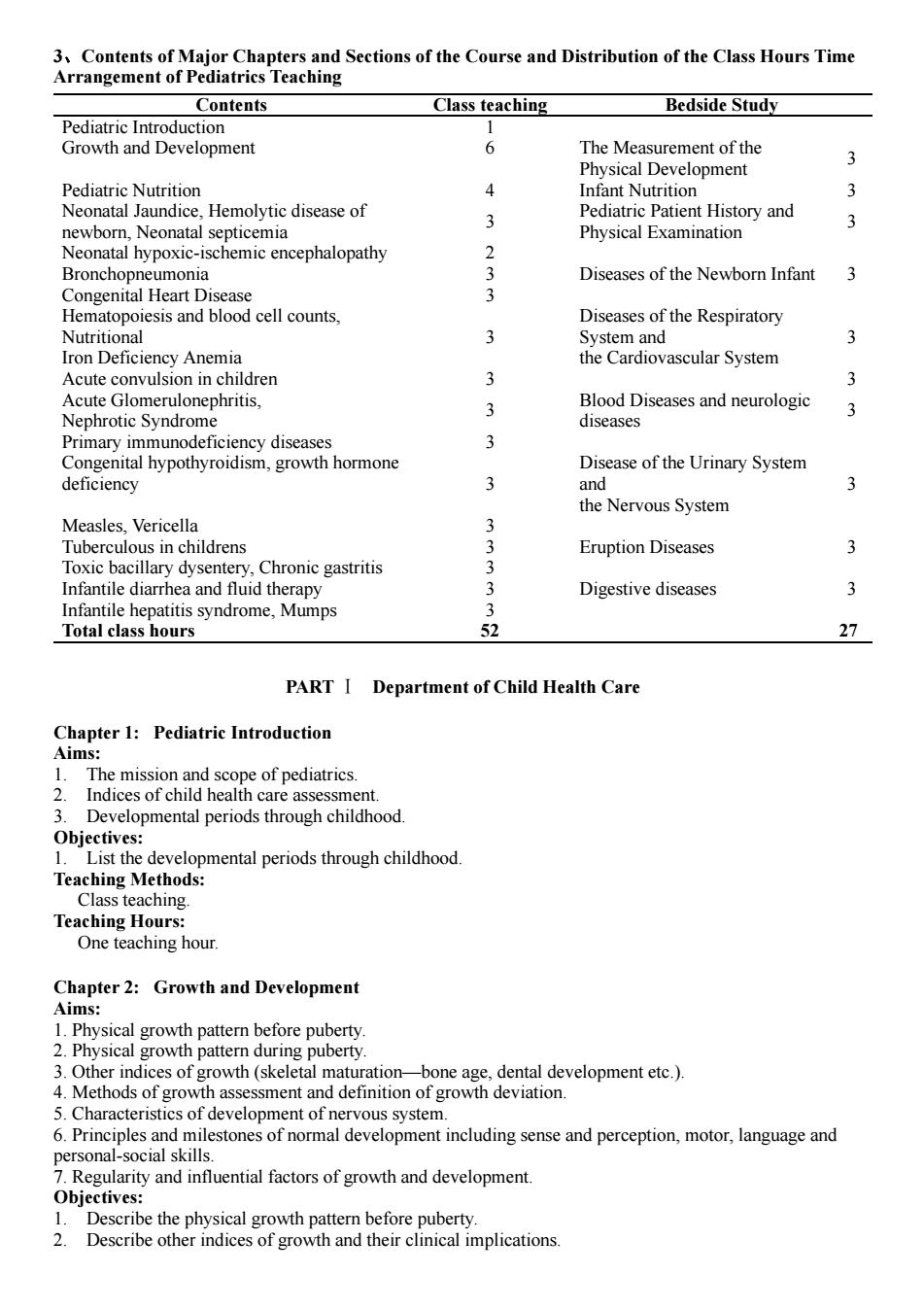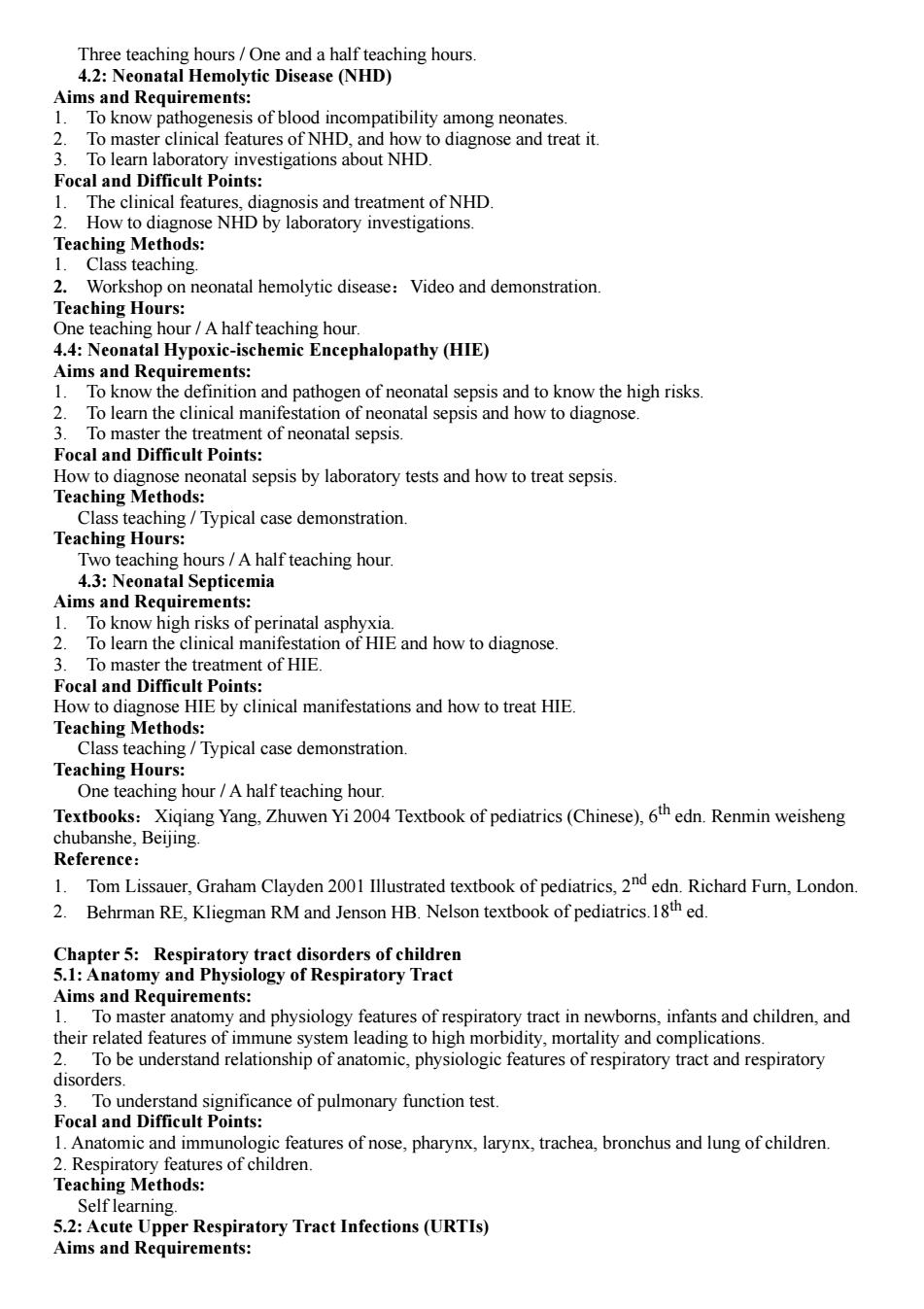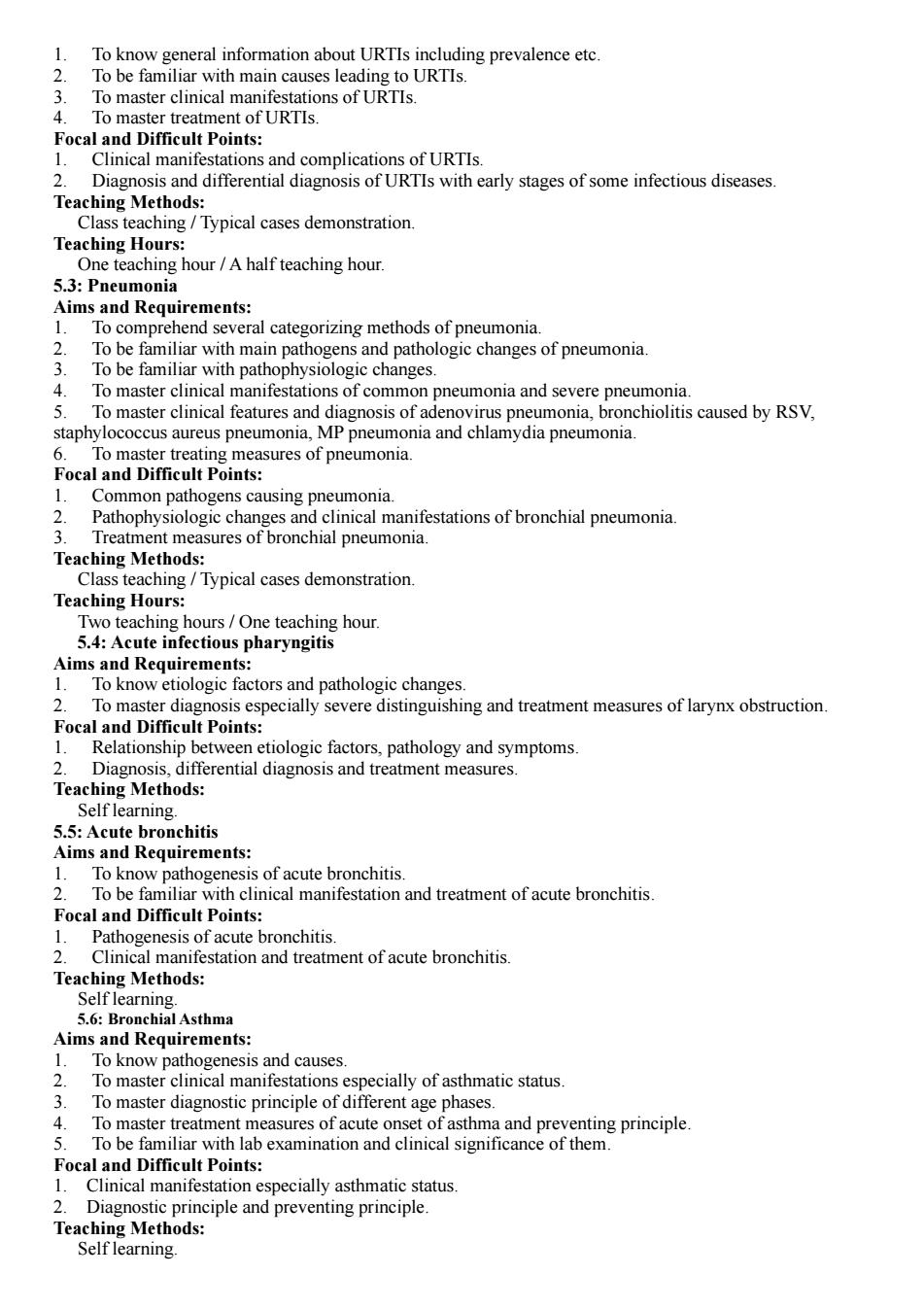
Teaching Outline for Pediatrics CoursePediatric College ofChongqing Medical University2001 1st Edition, 2007 2nd Edition, 2011 3rd EditionContent of Teaching OutlinePreface13Part IChapter 1Chapter 2-33Chapter 3-Part IIChapter 4-4-6Chapter 5--8Chapter 6--9 Chapter 7--9Chapter 8-Chapter 9--11Chapter 10-Chapte 1I--12-13 Part III--13Chapter 12-13Chapter 13.--14Chapter 14-Chapter 15-Chapter 16-15 Chapter 17---16Chapter 18-Teaching Outline for Pediatrics Course1, Course Title: Pediatrics2, Course General DescriptionPediatricsasoneofthemost important medicalsciencesaimstostudychildhoodgrowthanddevelopment,toimprovehhhaieationodoaeeyearsundergraduatecourseforoverseasdentsfromNalmtotranhmomqualifiedclinicaldoctorswiththesickwledohdiatidsaseshourrqurthathsudenshaabilirognizaayisasn dsh,bedside teaching (27classhours)and clinical practice
Teaching Outline for Pediatrics Course Pediatric College of Chongqing Medical University 2001 1 st Edition, 2007 2 nd Edition, 2011 3 rd Edition Content of Teaching Outline Preface-1 PartⅠ-3 Chapter 1-3 Chapter 2-3 Chapter 3-3 Part Ⅱ-4 Chapter 4-4 Chapter 5-6 Chapter 6-8 Chapter 7-9 Chapter 8-9 Chapter 9-11 Chapter 10-11 Chapter 11-12 Part Ⅲ-13 Chapter 12-13 Chapter 13-13 Chapter 14-14 Chapter 15-14 Chapter 16-15 Chapter 17-15 Chapter 18-16 Teaching Outline for Pediatrics Course 1、Course Title:Pediatrics 2、Course General Description Pediatrics as one of the most important medical sciences aims to study childhood growth and development, to improve the health level and the qualification of the disease prevention and treatment. Due to the growth and the development of the children, pediatric diseases present very different characteristics from that in the adults. Pediatric subject designed as the 5 years under graduate course for oversea students from Nepal aims to train them to become qualified clinical doctors with the basic knowledge on the pediatric diseases. The course require that the students have the ability to recognize, analysis and solve the problem often occurred in the pediatric patients after the 5 year study. Based on the requirements and the aims of the course, the teaching process includes class teaching (52 class hours), bedside teaching (27 class hours) and clinical practice

3, Contents of Major Chapters and Sections of the Course and Distribution of the Class Hours TimeArrangement ofPediatrics TeachingContentsClass teachingBedside StudyPediatric Introduction16The Measurement of theGrowth and Development3Physical DevelopmentPediatric Nutrition43Infant NutritionNeonatal Jaundice, Hemolytic disease ofPediatric Patient History and33newborn,NeonatalsepticemiPhysicalExamination233Neonatal hypoxic-ischemic encephalopathyDiseases of the Newborn InfantBronchomonianeurCongenital Heart Dismatopoiesis and blood cellcountsDiseases of the Respiratory3VutriSysteman3Iron Deficiency Anemithe Cardiovascular SystemAcuteconvulsion inchildren33Blood Diseases and neurologicAcute Glomerulonephritis,33NephroticSyndromediseasePrimary immunodeficiency diseases3Congenital hypothyroidism,growth hormoneDisease of the Urinary System33deficiencyanothe Nervous SystemMeasles, Vericella3333Tuberculous in childrensEruption DiseasesToxic bacillary dysentery,Chronic gastris3332Digestive diseasesInfantilediarrhea and fluid therapyInfantile hepatitis syndrome, Mumps27Total class hoursPART I Department of Child Health CareChapter 1: Pediatric IntroductionAimsThe mission and scope of pediatrics.Indices of child healthcareasseDevelopmental periods through childhood.ObjectiList the developmental periods through childhood.Teaching Methods: Class teaching.Teaching Hours:One teaching hourChapter 2: Growth and DevelopmentAims1. Physical growth pattern before puberty2.Physical growth patterrpuberty3. Other indices of growth (skeletal maturationbone age, dental development etc.)4. Methods ofsment and definition ofgrowth deviation5.Characteristics of developmmentof nervous system6. Principles and milestones of normal development including sense and perception, motor, language andpersonal-social skills7.Regularity and influential factors of growth and development.Objectives:Describe the physical growth pattern before puberty.Describe other indices of growth and their clinical implications
3、Contents of Major Chapters and Sections of the Course and Distribution of the Class Hours Time Arrangement of Pediatrics Teaching Contents Class teaching Bedside Study Pediatric Introduction 1 Growth and Development 6 The Measurement of the Physical Development 3 Pediatric Nutrition 4 Infant Nutrition 3 Neonatal Jaundice, Hemolytic disease of newborn, Neonatal septicemia 3 Pediatric Patient History and Physical Examination 3 Neonatal hypoxic-ischemic encephalopathy 2 Bronchopneumonia 3 Diseases of the Newborn Infant 3 Congenital Heart Disease 3 Hematopoiesis and blood cell counts, Nutritional Iron Deficiency Anemia 3 Diseases of the Respiratory System and the Cardiovascular System 3 Acute convulsion in children 3 3 Acute Glomerulonephritis, Nephrotic Syndrome 3 Blood Diseases and neurologic diseases 3 Primary immunodeficiency diseases 3 Congenital hypothyroidism, growth hormone deficiency 3 Disease of the Urinary System and the Nervous System 3 Measles, Vericella 3 Tuberculous in childrens 3 Eruption Diseases 3 Toxic bacillary dysentery, Chronic gastritis 3 Infantile diarrhea and fluid therapy 3 Digestive diseases 3 Infantile hepatitis syndrome, Mumps 3 Total class hours 52 27 PART Ⅰ Department of Child Health Care Chapter 1: Pediatric Introduction Aims: 1. The mission and scope of pediatrics. 2. Indices of child health care assessment. 3. Developmental periods through childhood. Objectives: 1. List the developmental periods through childhood. Teaching Methods: Class teaching. Teaching Hours: One teaching hour. Chapter 2: Growth and Development Aims: 1. Physical growth pattern before puberty. 2. Physical growth pattern during puberty. 3. Other indices of growth (skeletal maturation—bone age, dental development etc.). 4. Methods of growth assessment and definition of growth deviation. 5. Characteristics of development of nervous system. 6. Principles and milestones of normal development including sense and perception, motor, language and personal-social skills. 7. Regularity and influential factors of growth and development. Objectives: 1. Describe the physical growth pattern before puberty. 2. Describe other indices of growth and their clinical implications

Discuss some methods for growth assessment.Define the key terms such as growth deviationList and discuss the principles and milestones of normal development.Teaching MethocClass teaiching /Workshop.Teaching HoursSix teaching hours / Three teaching hoursChapter 3: Nutrition and Feeding3.1:Introduction of NutritionAimsDefinition of Enerequirement and theerequirement at different age groupducedby3maEnergyponutrienThe RNI (Recommended Nutrients Intake) of micronutrientristics of child's digestive system development relating with feeding skills (development ofharagastrointestinal kinesis and flora)e enzyme relating with the digestion and absorption of3 macronutrientsMaofdigestObjectiveList the energy requirement at different age group, especially during infancy.List theproportion of energyproduced by3macronutrients.ist the RNI of some micronutrients (VitA, VitB, VitC, VitD, ferri, calcium).Teaching MethodsClass teaching / Workshop.Teaching Hoursrs / One and a half teaching hours3.2: Infant FeedingAimAdvantages of breast milk and the proper technique of breast-feeding.Energy and nutrient composition in breast milk and cow's milkDifferent methods of infant feeding (breast-feeding, bottle-feeding and partial breast-feeding).The requirement of energy and protein intake for less than 6 months old infancy fed by breast or cow'smilkProper time, supplementary food and feeding methods for infancyObjectivesges of breast milk.hetheaoSommiCalculate the requirement of energy and protein intake for infancy less than 6 months old.1Describe what, when and how to introduce supplementary food for younger infancy.Teaching Methods: Class teaching /WorkshopTeaching Hours: Two teaching hours / One and a half teaching hours.PART II Department of Pediatric MedicineChapter 4: Neonatal diseases4.l:Neonatal jaundiceAims and RequiremennirbinmetabolisneonatedphvsiologicaljaureonatesTolearn common causes of neonatal jaundice and toknowtheclinical featuresof thenTo know the high risks and clinical features of kernicterus, and to know how to prophylaxis.Focal and Difficult PointsThe clinical features and common causes of neonatal pathological jaundice5Howgnoseandtreat neonatal jaundiceTeaching MetthodClass teaching.Workshoponneonatal jaundiceVideo,typicalcasedemonstrationandPBLTeaching Hour
3. Discuss some methods for growth assessment. 4. Define the key terms such as growth deviation. 5. List and discuss the principles and milestones of normal development. Teaching Methods: Class teaching / Workshop. Teaching Hours: Six teaching hours / Three teaching hours. Chapter 3: Nutrition and Feeding 3.1: Introduction of Nutrition Aims: 1. Definition of Energy requirement and the energy requirement at different age group. 2. Energy produced by 3 macronutrients. 3. The RNI (Recommended Nutrients Intake) of micronutrients. 4. Characteristics of child’s digestive system development relating with feeding skills (development of digestive enzyme, gastrointestinal kinesis and flora). 5. Maturation of digestive enzyme relating with the digestion and absorption of 3 macronutrients. Objectives: 1. List the energy requirement at different age group, especially during infancy. 2. List the proportion of energy produced by 3 macronutrients. 3. List the RNI of some micronutrients (VitA, VitB, VitC, VitD, ferri, calcium). Teaching Methods: Class teaching / Workshop. Teaching Hours: Two teaching hours / One and a half teaching hours. 3.2: Infant Feeding Aims: 1. Advantages of breast milk and the proper technique of breast-feeding. 2. Energy and nutrient composition in breast milk and cow’s milk. 3. Different methods of infant feeding (breast-feeding, bottle-feeding and partial breast-feeding). 4. The requirement of energy and protein intake for less than 6 months old infancy fed by breast or cow’s milk. 5. Proper time, supplementary food and feeding methods for infancy. Objectives: 1. Describe the advantages of breast milk. 2. Compare breast milk to cow’s milk. 3. Calculate the requirement of energy and protein intake for infancy less than 6 months old. 4. Describe what, when and how to introduce supplementary food for younger infancy. Teaching Methods: Class teaching / Workshop. Teaching Hours: Two teaching hours / One and a half teaching hours. PART Ⅱ Department of Pediatric Medicine Chapter 4: Neonatal diseases 4.1: Neonatal jaundice Aims and Requirements: 1. To learn features of bilirubin metabolism among neonates. 2. To master the difference between pathological jaundice and physiological jaundice of neonates. 3. To learn common causes of neonatal jaundice and to know the clinical features of them. 4. To know the high risks and clinical features of kernicterus, and to know how to prophylaxis. Focal and Difficult Points: 1. The clinical features and common causes of neonatal pathological jaundice. 2. How to diagnose and treat neonatal jaundice. Teaching Methods: 1. Class teaching. 2. Workshop on neonatal jaundice:Video, typical case demonstration and PBL. Teaching Hours:

Three teaching hours / One and a half teaching hours4.2: Neonatai Hemolytic Disease (NHD)Aims and Requirementsogenesisof bloodincompatibilityamongneonateoknowpaclinicalfeatures ofNHD,andHwtodiagnoseand treat itTomastervestigations about NHD.Focal and Difficult PointsThe clinical features, diagnosis and treatment ofNHDHow to diagnose NHD by laboratory investigations.2Teaching MethodsClass teaching.2Workshop on neonatal hemolytic disease:Video and demonstration.Teaching Hoursr/Ahalfteachinghouneteachir4.4: Neonatal Hypoxic-ischemic Encephalopathy (HIE)n and pathogen of neonatal sepsis and to know the high risksToknowtheitiTolearntheclinical manifestatioon ofneonatal sepsis and howtodiagnoseTo master the treatment of neonatal sepsisFocal and Difficult PointsHow to diagnlose neonatal sepsis by laboratory tests and how to treat sepsisTeaching MethodsClass teaching / Typical case demonstrationTeaching Hourshalf teaching hour4.3: NconatalAims and RequirementsToknowhigh risks of perinatal asphyxiaTo learn the clinical manifestation of HIE and how to diagnose.atmentof HIEomasterthetreaFocal and Difficult PoinHow to diagnose HIE by clinical manifestations and how to treat HIELeachinghVethodlTypical case demonstration.lang/TeaOne teaching hour / A half teaching hourTextbooks: Xiqiang Yang, Zhuwen Yi 2004 Textbook of pediatrics (Chinese), 6th edn. Renmin weishengchubanshe,Beijing.Referenceom Lssauer, Graham Clayden20llustrated textbookof pediatrics, 2nd edn Richard Furn, LondonBehrman RE, Kliegman RM and Jenson HB. Nelson textbook of pediatrics.18th edChapter 5: Respiratory tract disorders of children5.1:Anatomy and Physiology of Respiratory TractAims and Requirements master anatomy and physiology features of respiratory tract in newborns, infants and children, andtheirrelatedorbiditymortalityandcomplicatiorfeafuressvsteeadingtohighmorunderstand relationship of anatomic,physiologic features of respiratory tract and respiratorydisorderTo understand significance of pulmonary function test.Focal and Difficult Points. Anatomic and immunologic features of nose, pharynx, larynx, trachea, bronchus and lung of children2.Respiratory features of childrenTeachingMethods:elf learning5.2: Acute Upper Respir:ory Tract Infections (URTISs)Aims and Requirements
Three teaching hours / One and a half teaching hours. 4.2: Neonatal Hemolytic Disease (NHD) Aims and Requirements: 1. To know pathogenesis of blood incompatibility among neonates. 2. To master clinical features of NHD, and how to diagnose and treat it. 3. To learn laboratory investigations about NHD. Focal and Difficult Points: 1. The clinical features, diagnosis and treatment of NHD. 2. How to diagnose NHD by laboratory investigations. Teaching Methods: 1. Class teaching. 2. Workshop on neonatal hemolytic disease:Video and demonstration. Teaching Hours: One teaching hour / A half teaching hour. 4.4: Neonatal Hypoxic-ischemic Encephalopathy (HIE) Aims and Requirements: 1. To know the definition and pathogen of neonatal sepsis and to know the high risks. 2. To learn the clinical manifestation of neonatal sepsis and how to diagnose. 3. To master the treatment of neonatal sepsis. Focal and Difficult Points: How to diagnose neonatal sepsis by laboratory tests and how to treat sepsis. Teaching Methods: Class teaching / Typical case demonstration. Teaching Hours: Two teaching hours / A half teaching hour. 4.3: Neonatal Septicemia Aims and Requirements: 1. To know high risks of perinatal asphyxia. 2. To learn the clinical manifestation of HIE and how to diagnose. 3. To master the treatment of HIE. Focal and Difficult Points: How to diagnose HIE by clinical manifestations and how to treat HIE. Teaching Methods: Class teaching / Typical case demonstration. Teaching Hours: One teaching hour / A half teaching hour. Textbooks:Xiqiang Yang, Zhuwen Yi 2004 Textbook of pediatrics (Chinese), 6th edn. Renmin weisheng chubanshe, Beijing. Reference: 1. Tom Lissauer, Graham Clayden 2001 Illustrated textbook of pediatrics, 2nd edn. Richard Furn, London. 2. Behrman RE, Kliegman RM and Jenson HB. Nelson textbook of pediatrics.18th ed. Chapter 5: Respiratory tract disorders of children 5.1: Anatomy and Physiology of Respiratory Tract Aims and Requirements: 1. To master anatomy and physiology features of respiratory tract in newborns, infants and children, and their related features of immune system leading to high morbidity, mortality and complications. 2. To be understand relationship of anatomic, physiologic features of respiratory tract and respiratory disorders. 3. To understand significance of pulmonary function test. Focal and Difficult Points: 1. Anatomic and immunologic features of nose, pharynx, larynx, trachea, bronchus and lung of children. 2. Respiratory features of children. Teaching Methods: Self learning. 5.2: Acute Upper Respiratory Tract Infections (URTIs) Aims and Requirements:

To know general information about URTIs including prevalence etc.1.2To be familiar with main causes leading to URTIstions ofURTIsmasterclinicamatofURTIsFocal and Difficult PoinClinical manifestations and complications of URTIsDiagnosis and differential diagnosis ofURTIs with early stages of some infectious diseasesTeaching MethodsClass teaching /Typical cases demonstration.Teaching HoursOne teaching hour / A half teaching hour.5.3: PneumoniaAims and Requirementategorizing methods of pneumoniaiarwithmainnd pathologic changes of pneumoniaTo befamiliar with pathophysiologic changeTo master clinical manifestations of common pneumonia and severe pneumoniao master clinical features and diagnosis of adenovirus pneumonia. bronchiolitis caused by RsVstaphylococcus aureus pneumonia, MP pneumonia and chlamydia pneumoniatreatinmeasuresofpneumonia.Focal and Difficult CommonpathogenscausingpneumonianifestationsofbronchialpneumoniaohyTresofbronchialpneumoniaTeaching MethodscaClass teaching/Typical cases demonstration.Teaching HoursTwo teaching hours / One teaching hour5.4:Acute infectious pharyngitisAims and Requirementsndpathologicchangesoknovetiologicfactorssis especially severe distinguishing and treatment measures of larynx obstructionFocal and Difficult PoinRelationship between etiologic factors, pathology and symptomsDiagnosis, differential diagnosis and treatment measures.Teaching Methods:Self learning.5.5: Acute bronchitisAims and Requirementsisof acutebronchitishooennowbatclinical manifestation and treatment of acute bronchitisFocal and Difficult Pointis of acute bronchitisPathogenesClinical manifestation and treatment of acute bronchitis.Teaching Methods:Self learnir5.6:BronchialAsthmegurenTo master clinical manifestations esspecially of asthmatic statusTo master diagnostic principle of different age phasesTo master treatment measures of acute onset of asthma and preventing principle.befamiliarwithlabexaminationandclinical significanceofthemFocal and Difficult Pointsinical manifestation especially asthmatic status.Diagnostic principle and preventing principle.Teaching MethodsSelf learning
1. To know general information about URTIs including prevalence etc. 2. To be familiar with main causes leading to URTIs. 3. To master clinical manifestations of URTIs. 4. To master treatment of URTIs. Focal and Difficult Points: 1. Clinical manifestations and complications of URTIs. 2. Diagnosis and differential diagnosis of URTIs with early stages of some infectious diseases. Teaching Methods: Class teaching / Typical cases demonstration. Teaching Hours: One teaching hour / A half teaching hour. 5.3: Pneumonia Aims and Requirements: 1. To comprehend several categorizing methods of pneumonia. 2. To be familiar with main pathogens and pathologic changes of pneumonia. 3. To be familiar with pathophysiologic changes. 4. To master clinical manifestations of common pneumonia and severe pneumonia. 5. To master clinical features and diagnosis of adenovirus pneumonia, bronchiolitis caused by RSV, staphylococcus aureus pneumonia, MP pneumonia and chlamydia pneumonia. 6. To master treating measures of pneumonia. Focal and Difficult Points: 1. Common pathogens causing pneumonia. 2. Pathophysiologic changes and clinical manifestations of bronchial pneumonia. 3. Treatment measures of bronchial pneumonia. Teaching Methods: Class teaching / Typical cases demonstration. Teaching Hours: Two teaching hours / One teaching hour. 5.4: Acute infectious pharyngitis Aims and Requirements: 1. To know etiologic factors and pathologic changes. 2. To master diagnosis especially severe distinguishing and treatment measures of larynx obstruction. Focal and Difficult Points: 1. Relationship between etiologic factors, pathology and symptoms. 2. Diagnosis, differential diagnosis and treatment measures. Teaching Methods: Self learning. 5.5: Acute bronchitis Aims and Requirements: 1. To know pathogenesis of acute bronchitis. 2. To be familiar with clinical manifestation and treatment of acute bronchitis. Focal and Difficult Points: 1. Pathogenesis of acute bronchitis. 2. Clinical manifestation and treatment of acute bronchitis. Teaching Methods: Self learning. 5.6: Bronchial Asthma Aims and Requirements: 1. To know pathogenesis and causes. 2. To master clinical manifestations especially of asthmatic status. 3. To master diagnostic principle of different age phases. 4. To master treatment measures of acute onset of asthma and preventing principle. 5. To be familiar with lab examination and clinical significance of them. Focal and Difficult Points: 1. Clinical manifestation especially asthmatic status. 2. Diagnostic principle and preventing principle. Teaching Methods: Self learning